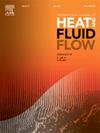Direct numerical simulation of vortex structures and fluctuating energy transfer in boundary layers with streamwise-adjacent roughness elements
IF 2.6
3区 工程技术
Q2 ENGINEERING, MECHANICAL
International Journal of Heat and Fluid Flow
Pub Date : 2025-07-08
DOI:10.1016/j.ijheatfluidflow.2025.109979
引用次数: 0
Abstract
Roughness elements on a smooth surface can promote transition within the boundary layer. It is crucial to elucidate the flow field structure changes for surface heat transfer and flow resistance control. To investigate the impact of streamwise adjacent roughness elements on plate boundary layer, this study conducts direct numerical simulation of flows over upstream roughness element characterized by three distinct shapes and downstream cylinder. The changes of the downstream vortex structures and fluctuating flow field caused by different upstream element shapes are revealed by specifically analyzing the streamwise vorticity stimulating term, first and second moments of velocity, fluctuating kinetic energy distributions and budget, fluctuating velocity anisotropy, and the coherent structures. The findings indicate that both the mixing enhancement of round head and the ramp’s intense shear can diminish the wavelength of downstream spanwise vortices resulting in a denser hairpin vortex cluster and make the central low-speed region more compact. The following enhanced downstream streamwise vortex pair exerts a lifting effect on the boundary layer, which weakens the interaction between the energetic structures induced by the upstream roughness element and the downstream cylinder. This reduction is reflected in smaller production and dissipation terms within the fluctuating kinetic energy budget near the roughness element height. In the fluctuating velocity anisotropy contours, the reduction is manifested far downstream as the distinct unidirectional developing regions and the middle isotropic regions. The robust shear of the ramp fosters the generation of spanwise and streamwise vorticity, thereby stimulating the formation of hairpin vortex clusters. Concurrently, the flow encircling the rounded head efficiently blends coherent structures across varying elevations. This blending phenomenon extends its influence into the far downstream region.
具有顺流相邻粗糙度单元的边界层涡结构和波动能量传递的直接数值模拟
光滑表面上的粗糙元素可以促进边界层内的过渡。研究流场结构的变化对表面传热和流动阻力的控制至关重要。为了研究顺流相邻粗糙度单元对板边界层的影响,本研究对上游具有三种不同形状的粗糙度单元和下游圆柱体的流动进行了直接数值模拟。通过具体分析流向涡量刺激项、速度一阶矩和二阶矩、脉动动能分布和平衡、脉动速度各向异性和相干结构,揭示了不同上游单元形状引起的下游涡结构和脉动流场的变化。结果表明,圆头的混合增强和坡道的强烈剪切都可以减小下游展向涡的波长,从而使发夹涡团更加密集,使中心低速区更加紧凑。随后增强的下游顺流涡对对边界层产生抬升作用,减弱了上游粗糙度单元与下游柱体诱导的能态结构之间的相互作用。这种减少反映在粗糙度单元高度附近的波动动能收支中较小的产生和耗散项。在波动速度各向异性等值线上,减少表现在较下游明显的单向发育区和中部各向同性区。坡道的强大剪切促进了向展向和向流涡度的产生,从而刺激了发夹涡簇的形成。同时,围绕圆形头部的流动有效地融合了不同高度的连贯结构。这种混合现象的影响延伸到远下游地区。
本文章由计算机程序翻译,如有差异,请以英文原文为准。
求助全文
约1分钟内获得全文
求助全文
来源期刊

International Journal of Heat and Fluid Flow
工程技术-工程:机械
CiteScore
5.00
自引率
7.70%
发文量
131
审稿时长
33 days
期刊介绍:
The International Journal of Heat and Fluid Flow welcomes high-quality original contributions on experimental, computational, and physical aspects of convective heat transfer and fluid dynamics relevant to engineering or the environment, including multiphase and microscale flows.
Papers reporting the application of these disciplines to design and development, with emphasis on new technological fields, are also welcomed. Some of these new fields include microscale electronic and mechanical systems; medical and biological systems; and thermal and flow control in both the internal and external environment.
 求助内容:
求助内容: 应助结果提醒方式:
应助结果提醒方式:


